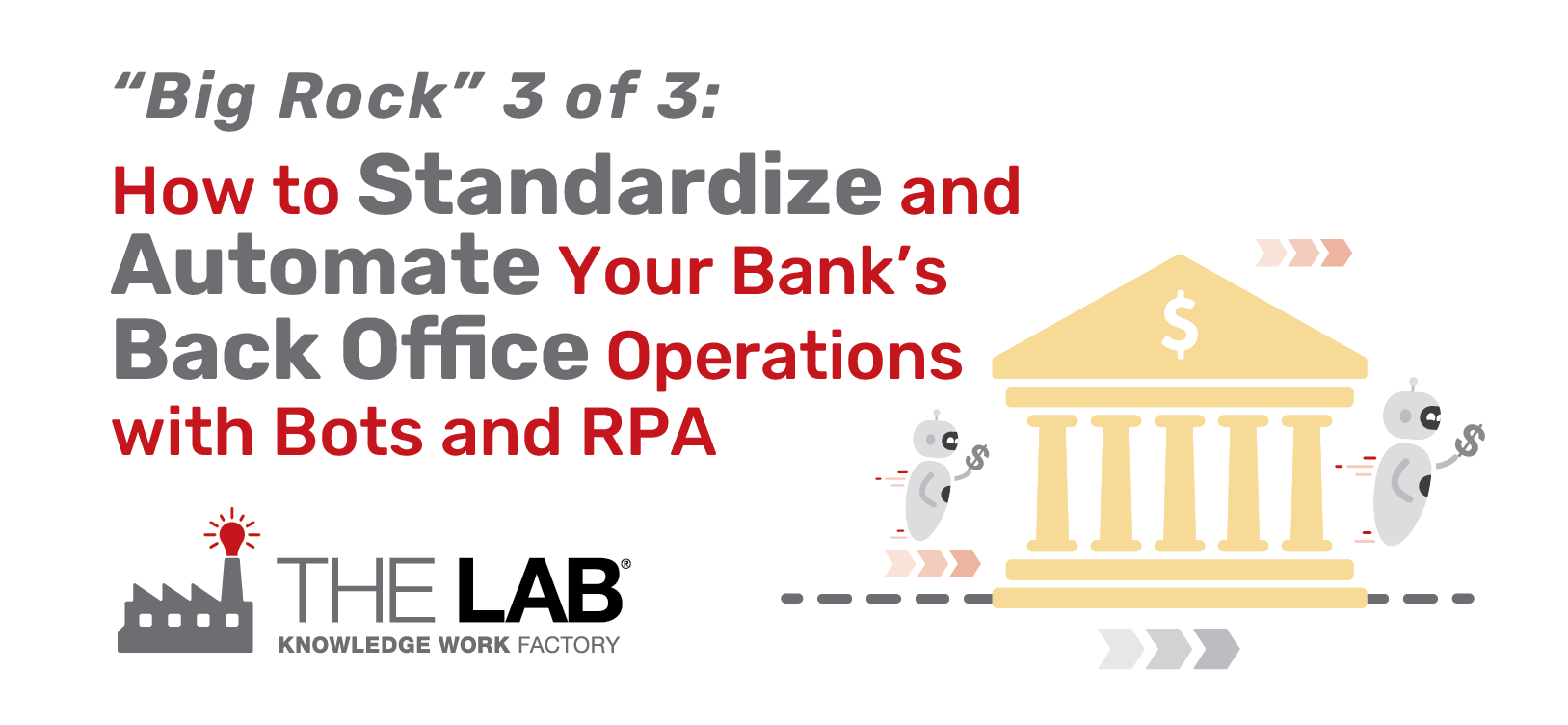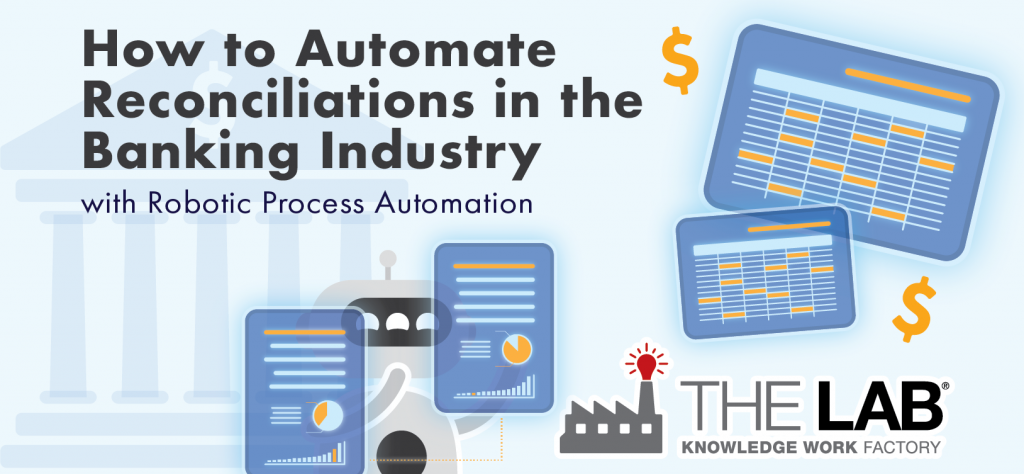This blog post is part 3 of the 3-part “Big Rocks” series on how to strategically lower costs, increase operating leverage, improve customer experience, and automate what wasn’t automatable in your bank.
- Big Rock 1: Retail branch network. You need data-driven decision-making to stop over-serving markets and locations—without damaging customer perceptions. Even without closures, your branch network represents 40% of the total savings potential.
- Big Rock 2: Lending—commercial and consumer. You already know that all sales producers are not created equal. But you don’t know how burdened all sales producers are by “NIGO” activities: “not in good order” rework and remediation. You need to eliminate these activities without impeding the performance of your revenue engine—while improving customer experience and revenue productivity. The next 35% of savings potential—and the trickiest—lies here.
- Big Rock 3: Back-office operations. Turbocharge speed and efficiency, while dramatically reducing costs, forever, with robotic process automation or RPA. A quarter of all savings reside here.
“Banking Big Rock” 3 of 3: Turbocharge back office operating leverage while boosting customer experience with automation
While most banks have “automated” their back-office operations using industry-standard core platforms, those operations are anything but automatic. To the contrary: Despite all the systems and add-ins, they’re a manual-labor, copy-click-and-paste nightmare, like a latter-day Dickens novel.
This isn’t just tragic. It’s wasteful. It puts highly educated (and highly paid) people to work doing mindless repetitive tasks. It saps resources. It invites error. It degrades customer experience with delays and errors. And most damagingly, it saps the bank of operating leverage: the ability to weather peaks and troughs of demand, without the need to increase or reduce staff.
Clearly, robotic process automation, or RPA, is the solution to this back-office backlog. These “robots” are simply software programs that can “sit at a computer,” just like a person, and log into servers, click, copy, paste, format, switch applications, send emails and so on… exactly as a human would. Except robots work infinitely faster than people. They don’t tire, take breaks, or make mistakes.
Imagine, then, the Holy Grail of back-office automation: A “lights-out factory,” with no humans at all, simply humming along. Many real factories achieved this level of automation years ago. Now, banks can do the same—or at least strive toward it.

Breaking Down the Bank’s Back Office
The back office is any bank’s lowest-hanging fruit for automation opportunity. In this article, we’ll break it down by “buckets,” in terms of both function and bot-enabling benefit.
But you might wonder, “Why aren’t all banks today automated already?”
It’s a good question. Indeed, most banks which report “bot success” hit a ceiling at only about ten robots, when the average bank today has opportunities for about 300 robots. Yes: three-hundred! (Maybe more.)
The short answer is that you must first identify the use-cases for bots. These aren’t always obvious. And the use-cases themselves must be bot-friendly. If they’re not, they need to be fixed. Example: Why give a customer a free-form text field for an address-change request? Standardize each field in the form, add lock-outs to prevent incomplete submissions, and a bot can sail through it.

At The Lab, we specialize in this kind of work. We’ve patented it. It’s called Knowledge Work Standardization™, and it’s the essential prerequisite for automating your banking back office. It includes things like cutting through “false complexity”: Some banks will have 40 processes for Deposit Ops; others will have 150. The difference? Only the bloated, redundant list of names.
Back-Office Process “Factories” for RPA
Today’s bank back office resembles a collection of small “factories” that are just begging to be automated. They include:
- Deposit Operations. Also known as Bank Operations, this includes a huge “long tail” of transactions, such as Reg. D letters, hot cards, etc. This “long tail” can be devilishly long: however, in most banks, the top four to six transactions account for more than 50 percent of the human work effort!
- Treasury Management (TM) Services Support. TM is the prime battleground for retaining commercial customers. This means that support service capabilities are critical. These include account implementation, ACH setup, wire processing, additional service onboarding (e.g., positive pay, sweep services, electronic accounts payable, etc.), and more. Automate these transactions, and your commercial customers will see the difference in speed, accuracy, and responsiveness.
- Wire Transfers. Why are people still doing all of this rote cut-copy-and-paste work? Over 70 percent is ideal for bots; most wire groups need to standardize first.
- Risk/Compliance. The processing of Reg. E letters alone often overwhelms back-office staff, leaving them with no “spare time” to investigate the causes which lead to this risk. Let bots do the drudge work so that humans can track down root causes and eliminate them (by working with the risk organization, which often lacks the detailed knowledge to run it down themselves).
- Customer Contact. This typically includes the call center, responding to web-based service requests, online chat, and so on. “There’s a bot for that.”
Breaking Down the Back Office RPA Bots
Here, then, are several categories of bots that can boost back-office productivity—increasing productivity “lift” while reducing operational “drag.”
Remember: The average bank has opportunities for about 300 robots. So, this is just a quick overview to whet your appetite!
Operating leverage/high-volume bots.
These bots handle work whose volume may fluctuate based on bank performance (i.e., organic growth), acquisition activity, product development and marketing (e.g., promotions), market conditions, and more. Examples include:
- ACH Stop-Payment Bots. For some banks, this sit-at-the-computer chore spans four systems that don’t talk to each other. For other banks, it’s as many as six. The Lab can implement a bot for any stop-payment protocol.
- Debit Card Fraud Processing RPA. One of these bots, installed by The Lab, delivered more than 1,400 hours of employee time and cost savings… in just three weeks!
- “Refer-A-Friend” Request Bots. When a promotion like this goes out, input spikes. Why staff up? Why overwhelm existing staff? Simply park a bot on this transaction.
https://www.youtube.com/watch?v=KrrLrxzPnEM
Customer experience (CX) bots.
Bots can help differentiate your bank across four different CX dimensions:
- Speed, e.g., same-day processing
- Transparency, e.g., proactive status updates
- Product features, e.g., improved account reporting
- Service quality, e.g., improved accuracy.
Bot examples include:
- Service-Charge Refund Bots. What could possibly make your customers happier than getting money they’re owed, faster? At one of The Lab’s banking clients, this was the highest-transaction-volume category in the entire back office. Let the bot do the drudge-work of reading requests, opening the core system, and making necessary changes.
- Business Customer Enrollment Bots. The Lab can implement a bot that opens the ticketing system, retrieves new-account-setup requests, extracts the info to Excel and processes it, and opens the new account in the digital banking system and the core. Then it emails stakeholders that the job is complete! All this takes just seconds.
- Pre-Approved Account Distribution Bots. Imagine a bot that automates 100 percent of this activity. It can be done; The Lab has done it. It’s an ad-hoc bot, which can be run daily or weekly.
And don’t worry about having to struggle over deciding between “false tradeoffs”—between improving productivity or enhancing customer experience. As you can see on the matrix chart below, the majority of operational productivity improvements—nearly 75 percent—have an impact on customer experience. And, of course that only makes sense. Customers appreciate faster, better, error-free service (especially if it costs less).

Risk/compliance bots.
These free up the capacity of highly-skilled risk analysts to focus on “big-ticket” risk-exposure items, or work to ensure upstream data accuracy and compliance. These bots can perform standard “low-to-mid” risk alerts, conduct batch reviews, and act as an early detection system for missing or incomplete data. Examples include:
- Suspicious Activity Report (SAR) Bots. Let a robot handle the data storage and assignment for things like anti-money-laundering (AML) compliance. It does the screen-scraping and Excel-loading, merges it into SQL, and emails a report to stakeholders—daily.
- Payment Fraud Processing Bots. A bot can do this easily. At your bank or credit union, processing check deposits that may need extended holds or denials due to concerns flagged by anti-fraud software, requires a ton of work from your beleaguered Deposit Ops staff. But now, you can get more done, faster, while hedging against employee turnover, using RPA bots from The Lab.
- Automated SOX System Access Review Compliance Bots. SOX reporting is a nightmare for any bank. So automate it with RPA bots from The Lab! Check out the below video link to an actual SOX system-identity and access-review bot.
Revenue-Productivity bots.
Bots can easily improve processing speed and accuracy, reduce avoidable follow-ups, and provide data to support sales efforts. They can also provide sales “intelligence” by gathering data and delivering prioritized leads and cross-sell opportunities. Examples include:
- “Cash-On-Hand” Bots. Wealth-management sales staff “don’t have the time” to contact customers with, say, just $10k in deposits. That’s because they won’t make much money on these accounts. But bots don’t care. They can locate these ripe, low-yield targets and perform the outreach, automatically—at scale.
- Online Account Opening Bots. This one bot installed by The Lab eliminates 80 percent of the manual workload for onboarding new accounts online! Not only that, it performs 20 minutes’ worth of human work in just three minutes!
- eDeposit Product Setup Bots. Imagine a bot that accesses the bank’s ticketing system, pulls the right data, reconciles two Excel sheets, processes 13 different steps in the core, updates the ticket, and then emails stakeholders. How can you not want a bot like that?
Too Many Banking RPA Bots to List
We could go on. And on. Consider watching these videos of real-life automations recently implemented for clients by The Lab.
Cross-Departmental Coordination bots.
This is an entire category of bots that improve communication and visibility between departments to reduce avoidable follow-ups, miscommunication, “slipping through the cracks,” etc. Think of that “Security upgrade from IT that no one knew about and became a back-office nightmare,” or that “Marketing promo which overloaded the contact center because they didn’t know it was coming.”
Reconciliation bots.
It’s a baked-in activity within practically every back-office banking bot we configure. That’s because every bank is saddled with “recons”—simply comparing two sets of data, to make sure they match—which takes a staffer hours of work each day. The Lab recently installed 30 “Recon Bots” at one bank, which eliminate the drudge work of seven full-time staffers!
Automate your back-office operations today!
Back-office automation isn’t fiction. It’s reality. Best of all, every bot described above can be installed remotely, from The Lab’s U.S. offices in Houston!



















